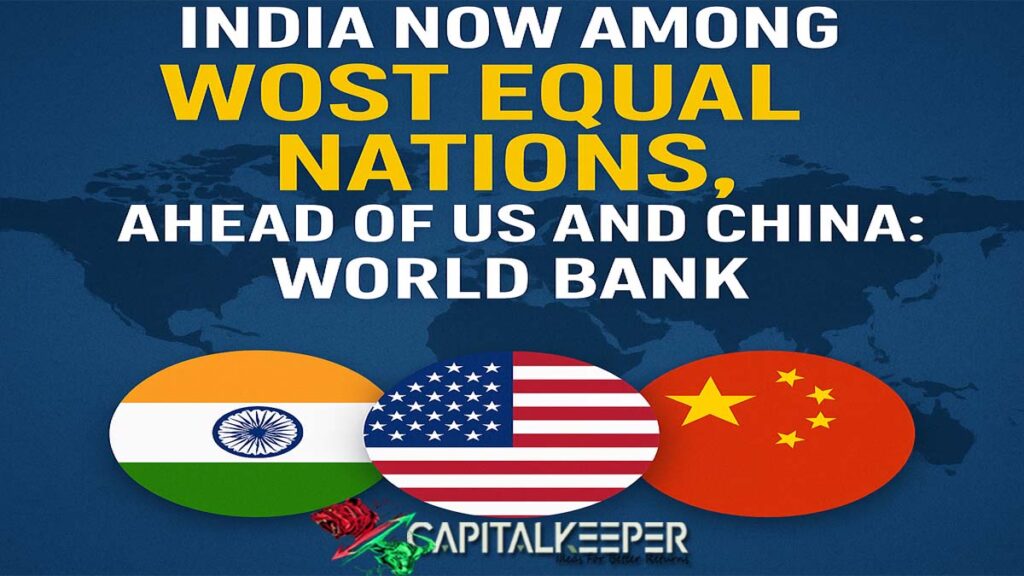India Emerges as One of the Most Equal Nations Globally: World Bank Report 2025
By CapitalKeeper | News | Indian Sock Market | Market Moves That Matter I 05th July 2025
🇮🇳 India Now Among World’s Most Equal Nations, Ahead of US and China: World Bank
In a landmark revelation, the World Bank has identified India as one of the world’s most equal nations, surpassing even developed economies like the United States and China in terms of income equality. This transformative shift not only alters the global economic narrative but also carries significant implications for investors, policymakers, and citizens alike.
🔍 Understanding the Report: What Does “Equality” Mean Here?
The World Bank measures economic equality using tools such as:
- Gini Coefficient (a statistical measure of income or wealth distribution)
- Income Quintile Shares
- Access to Basic Services
- Wealth Distribution and Consumption Metrics
In the latest dataset, India’s Gini coefficient was found to be significantly lower than that of the United States and China — indicating a narrower gap between the rich and the poor.
📈 India vs US & China: A Comparative Glance
| Country | Gini Coefficient (Lower = More Equal) | Notable Trends |
|---|---|---|
| 🇮🇳 India | 0.32 (est. 2025) | Rising rural income, strong redistribution policies |
| 🇨🇳 China | 0.47 | Urban-rural divide remains high |
| 🇺🇸 United States | 0.49 | High income inequality, concentrated wealth |
Key Takeaway:
India’s social welfare programs, financial inclusion (like Jan Dhan Yojana, Aadhaar-linked DBT), and rural infrastructure have collectively enabled broader wealth distribution.
💡 What’s Driving India’s Economic Equality?
Here are the core reasons behind this trend:
1. Direct Benefit Transfers (DBT) and Financial Inclusion
Over 500 million bank accounts opened under the Jan Dhan Yojana have enabled the government to transfer subsidies and welfare schemes directly, reducing leakages.
2. Digital Infrastructure & Aadhaar
India’s digital public infrastructure (DPI) has increased access to services in rural and semi-urban areas, reducing geographical inequality.
3. MSME Growth & Informal Sector Formalization
The rise in Micro, Small & Medium Enterprises (MSMEs) and schemes like MUDRA loans have helped lift many out of poverty and create decentralized income sources.
4. Social Schemes and Subsidies
From PMAY (housing) to Ayushman Bharat (health insurance), India’s welfare model has significantly contributed to inclusive growth.
🧠 Analyst’s Take: What This Means for Investors
✅ Stronger Domestic Consumption
Greater equality means more middle-class purchasing power. This supports:
- FMCG
- Auto & two-wheelers
- Banking & NBFCs (especially micro-lending)
✅ Lower Social Unrest Risks
Equal societies tend to have higher political stability, improving the long-term investment climate.
✅ Opportunities in Tier 2/3 Cities & Rural Markets
These geographies now have better incomes and digital penetration, making them prime targets for:
- E-commerce
- Fintech
- Education & EdTech
- Healthcare delivery models
❗ Caveat: Don’t Confuse Equality with Absolute Prosperity
India’s equality gains do not imply everyone is wealthy, but rather that wealth is less concentrated, and opportunities are more evenly distributed than before.
🔮 Future Outlook: Can India Sustain This Equality?
Maintaining this momentum will require:
- Continuous investment in education and skilling
- Tackling urban inequality
- Expanding the tax base and formalizing the gig economy
- Boosting women’s labor force participation
📝 Conclusion: A Historic Shift with Global Implications
India’s emergence as a relatively more equal nation than China and the US represents a structural shift in the global economic order. For investors, this signals a more resilient consumption-driven economy, and for citizens, a step towards shared prosperity.
As India marches toward becoming a $5 trillion economy, inclusive growth appears to be its strongest asset.
📊 Bonus Insight:
The next decade will belong to economies that are not just fast-growing, but also fair in distributing the fruits of growth. India seems poised to lead both fronts.
📌 For daily trade setups, technical learning, and smart investing tips, stay tuned to CapitalKeeper.in
📌 For more real-time updates, trade setups, and investment insights — follow us on [Telegram] and subscribe to our newsletter!
📌 Disclaimer
The content provided on CapitalKeeper.in is for informational and educational purposes only and does not constitute investment, trading, or financial advice. While we strive to present accurate and up-to-date market data and analysis, we make no warranties or representations regarding the completeness, reliability, or accuracy of the information.
Stock market investments are subject to market risks, and readers/investors are advised to conduct their own due diligence or consult a SEBI-registered financial advisor before making any investment decisions. CapitalKeeper and its authors are not liable for any loss or damage, direct or indirect, arising from the use of this information.
All views and opinions expressed are personal and do not reflect the official policy or position of any agency or organization. Past performance is not indicative of future results.By using this website, you agree to the terms of this disclaimer.

